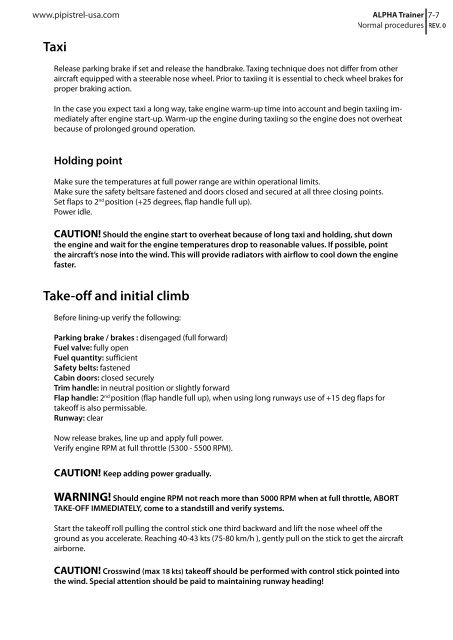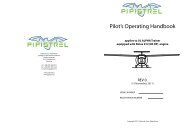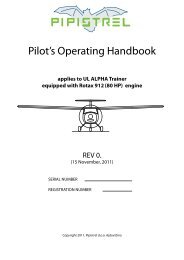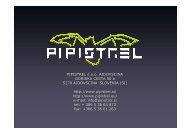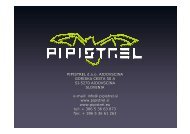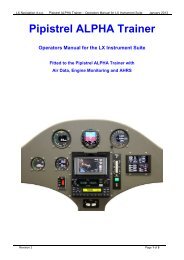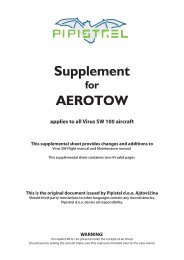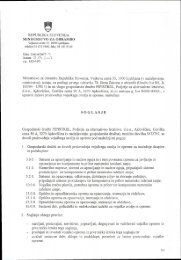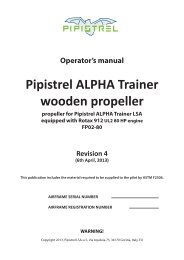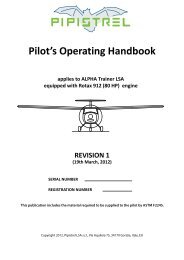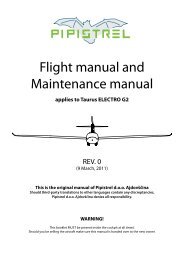ALPHA Trainer Manual Final.pdf - Pipistrel
ALPHA Trainer Manual Final.pdf - Pipistrel
ALPHA Trainer Manual Final.pdf - Pipistrel
Create successful ePaper yourself
Turn your PDF publications into a flip-book with our unique Google optimized e-Paper software.
www.pipistrel-usa.com<br />
<strong>ALPHA</strong> <strong>Trainer</strong> 7-7<br />
Normal procedures REV. 0<br />
Taxi<br />
Release parking brake if set and release the handbrake. Taxing technique does not differ from other<br />
aircraft equipped with a steerable nose wheel. Prior to taxiing it is essential to check wheel brakes for<br />
proper braking action.<br />
In the case you expect taxi a long way, take engine warm-up time into account and begin taxiing immediately<br />
after engine start-up. Warm-up the engine during taxiing so the engine does not overheat<br />
because of prolonged ground operation.<br />
Holding point<br />
Make sure the temperatures at full power range are within operational limits.<br />
Make sure the safety beltsare fastened and doors closed and secured at all three closing points.<br />
Set flaps to 2 nd position (+25 degrees, flap handle full up).<br />
Power idle.<br />
CAUTION! Should the engine start to overheat because of long taxi and holding, shut down<br />
the engine and wait for the engine temperatures drop to reasonable values. If possible, point<br />
the aircraft’s nose into the wind. This will provide radiators with airflow to cool down the engine<br />
faster.<br />
Take-off and initial climb<br />
Before lining-up verify the following:<br />
Parking brake / brakes : disengaged (full forward)<br />
Fuel valve: fully open<br />
Fuel quantity: sufficient<br />
Safety belts: fastened<br />
Cabin doors: closed securely<br />
Trim handle: in neutral position or slightly forward<br />
Flap handle: 2 nd position (flap handle full up), when using long runways use of +15 deg flaps for<br />
takeoff is also permissable.<br />
Runway: clear<br />
Now release brakes, line up and apply full power.<br />
Verify engine RPM at full throttle (5300 - 5500 RPM).<br />
CAUTION! Keep adding power gradually.<br />
WARNING! Should engine RPM not reach more than 5000 RPM when at full throttle, ABORT<br />
TAKE-OFF IMMEDIATELY, come to a standstill and verify systems.<br />
Start the takeoff roll pulling the control stick one third backward and lift the nose wheel off the<br />
ground as you accelerate. Reaching 40-43 kts (75-80 km/h ), gently pull on the stick to get the aircraft<br />
airborne.<br />
CAUTION! Crosswind (max 18 kts) takeoff should be performed with control stick pointed into<br />
the wind. Special attention should be paid to maintaining runway heading!


